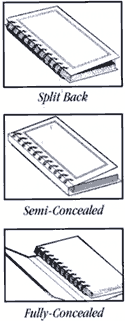|
Well-thought out cover designs can improve the appearance and functionality of
your next Wire-O project. Although there are many possible cover styles, three
of the most com mon are: Split back (separate front and back leaves),
semi-concealed and fully concealed wraparound designs.

|
Split Back
Split-Back
Covers. Attractive, twopiece split-back covers are a solid choice
when battling limited budgets and quick turnaround times. As long as
your book has common page dimensions, no tabs and a Wire-O diameter
size of 5/e" or less, flush-cut split back covers are hard to beat.
However, if thicker Wire-O is needed, design your two-piece cover
with '/ft" overhang to com pensate for text page push-out. If your
books need to be displayed on a shelf, recognize that split-back
covers don't permit spine printing and should be avoided.
Fully-Concealed and Semi-Concealed Covers
If you need spine printing, choose a fully-concealed or
semiconcealed design, either of which allows spine printing. Wraparound covers
hide Wire-O binding elements without sacrificing product functionality. It's up
to graphic arts service providers to help their customers design covers that are
pleasant to look at, yet retain all Wire-O advantages.
|

Job Planning
When you experience mechanical binding problems, poor cover planning is often at the root
of the problem. Before beginning production on any Wire-O cover, carefully plan
your entire job. For example, if you're working on a semi?concealed book, make a
bulking dummy, choose the right Wire-O size and finalize height and width
dimensions before laying out your cover. Unless you have complete job
information first, you run a significant risk of making a very expensive
production mistake.
If split-back Wire-O pages are printed in signature form,
production usually begins in a remarkably similar way to perfect binding. The
signatures need to be folded. All forms must be gathered, glued (only a skim
coat of glue is applied) and three-knife trimmed on a perfect binder. At this
point manufacturing processes diverge. The fourth side of the book blocks must
be trimmed off. Finally, the collated stack of loose sheets is punched and
individual books are Wire-O bound. (See table below.)
Semi-Concealed Wire-O Cover Planning
Process
| DETERMINE |
|
3:1 WIRE-O SIZES |
|
2:1 WIRE-O SIZES |
| 1) Wire Size |
|
For book blocks
thinner than 1/2", take your book block thickness, add 1/8" and
round to the nearest 1/16". |
|
For book blocks 1/2" to 7/8" thick, add
1/8" to bulk and round up to nearest 1/8".
|
| 2) Spine
Width |
|
Subtract 1/16" from the wire
size.
|
|
Same as 3:1 |
3)
Cover Width +
1/16"
Overhang
|
|
Text page width,
add Wire-O size, subtract 1/8". |
|
Same as 3:1, except
subtract 3/16". |
4) Cover
Score
Placement |
|
Place punching
score 5/16" from the nearest spine score. |
|
Same, but punching
score is 1/2" away |
If your project has a low page count, small quantity, or uses variably-sized leaves, different stocks,
foldouts, die cuts, tabs, or bind-ins, consider a second Wire-O manufacturing
method. In cases such as these, consider cutting sheets to final size and
collating them on a single sheet-style collating machine prior to punching and
binding. The best way to start is by involving your bindery professional early
in the job planning process so you make all the right decisions and get the
details right.
Scoring your covers properly is another detail that needs to be
considered. Semi-concealed covers should be scored in opposing directions.
Non-glued, fully-concealed six-page covers (see graphics at right) need all
scores going the same way. However, if the back two panels are glued
together - basically turning your cover into a four pager - an
opposing fourth score now is necessary.
Fully concealed covers are more
expensive than semi-concealed because they require more paper and slow down
turnaround times. Longer six-page forms are more difficult to handle and
frequently need to be hand punched because of their length. In contrast,
fourpage, semi-concealed covers usually can be automatically punched, as long as
the cover is thin enough. One advantage of leaving fully-concealed covers
unglued is that extra cover copy is available for easy reference or high priced
advertising.
When outsourcing your next Wire-O project, choose a post press
services company with a variety of production methods at its disposal. Some
desirable options are:
Signature gathering and gluing/single sheet
collating.
Automatic punching/manual punching
Automatic wire insertion/manual wire insertion
Shaped closing tools/flat closing tools
Alternative binding methods (i.e. plastic spiral,
perfect binding, saddle stitching, etc.)
With options comes flexibility. If your bindery partner has multiple manufacturing
methods available at their fingertips, you stand a better chance of getting
precisely the right solution for your projects.



|